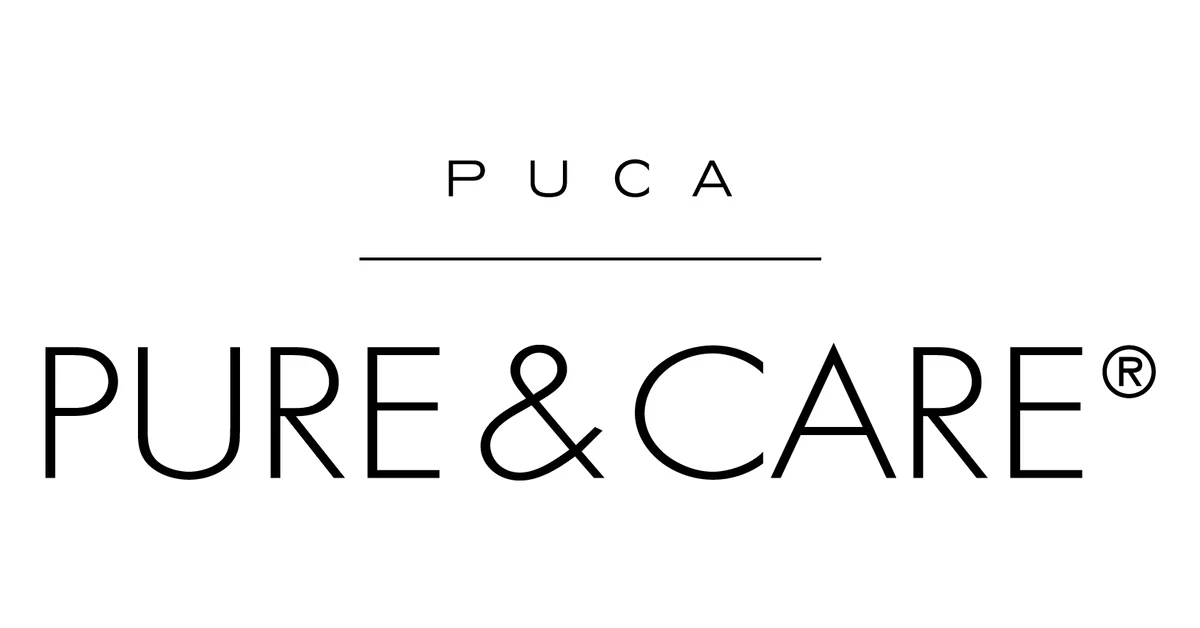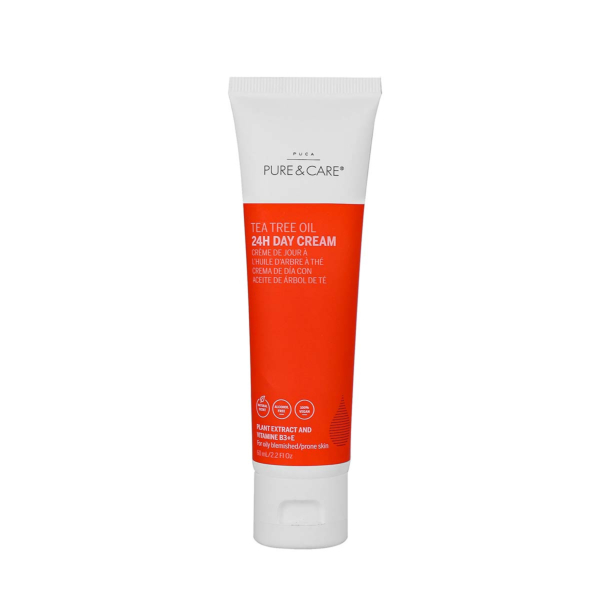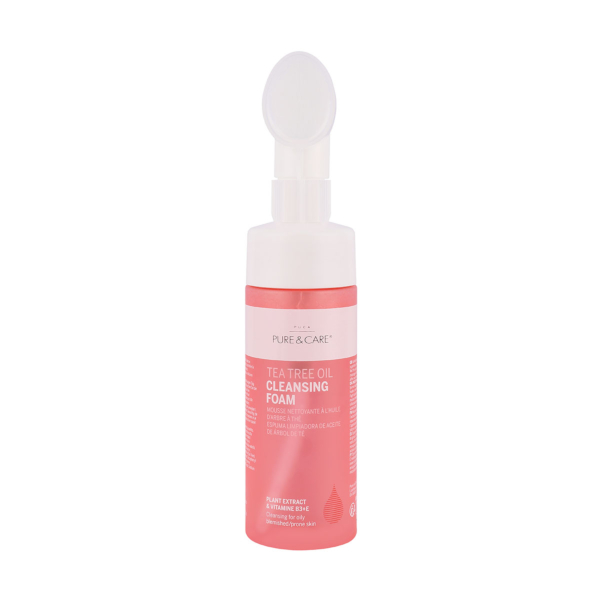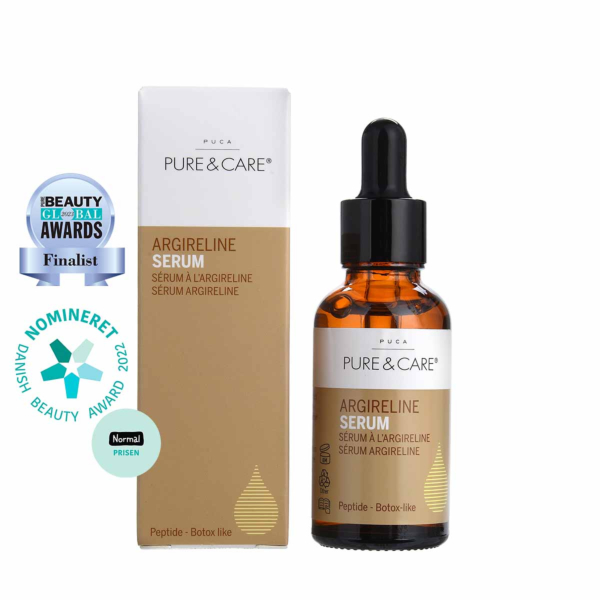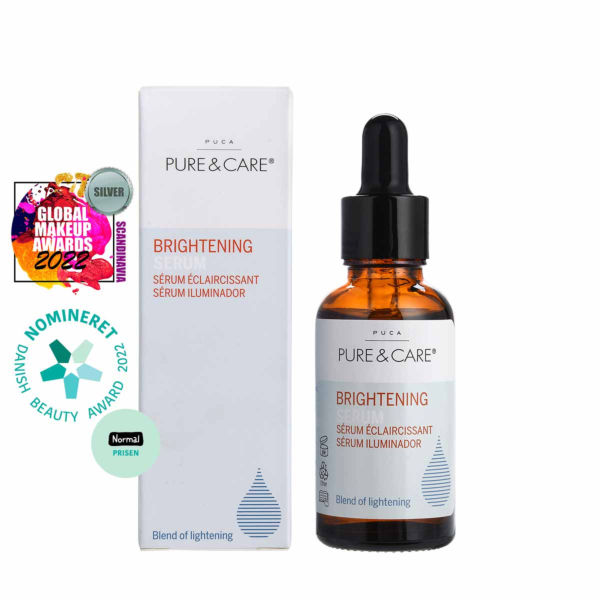Vitamin B
THE B VITAMINS
Vitamin B is a group of 8 different water-soluble vitamins: B1, B2, B3, B5, B6, B7, B9 and B12. These vitamins are very much interconnected in terms of their functions in the body: They play very important roles as coenzymes for various enzymes in the body – for example in energy metabolism, the immune system, and the nervous system and several of them are also important for DNA synthesis and DNA reconstruction.
Many studies have been done with the various B vitamins – especially B6, B9 and B12, but much is not yet known – for example, what the optimal intake of each of the vitamins is. Since they are part of very complex systems in the body and are interconnected, it can be difficult to study them individually. They are generally found in many foods, so deficiency is not often seen in countries with a good and varied food supply. As supplements, they are often found in the form of B vitamin complex, where all or more of them are included.
In relation to the skin, the B vitamins – as in the rest of the body – have important functions, but usually only some of them are used in cosmetics: Primarily B3 in the form of Niacinamide and B5 in the form of Panthenol and to a lesser extent B7 in the form of Biotin and B12 in the form of Cyanocobalamin.
PUCA - PURE & CARE uses D-Panthenol and Niacinamide in several products.
PRODUCTS WITH VITAMIN B
THE B VITAMINS
B1, B2, B3, B5, B6, B7, B9 og B12 – functions and systems in the body
The B vitamins were discovered in the years between 1910 and 1937 – the first to be discovered was B1. A number of other substances were also discovered in addition to the current 8 B vitamins, which at the time were thought to be vitamins and therefore they were assigned a number in the series. It has since been shown that these substances did not meet the requirements to be classified as a vitamin (a vital micronutrient that the body cannot produce itself at all or to a sufficient degree) and therefore today there are "gaps" in the number series.
The 8 B vitamins are chemically very different substances – and several of them occur in different forms, which the body is generally good at converting. Some of them are most often denoted by their B-number – e.g. B12 (Cobalamin), while others are most often denoted by their common name – e.g. Biotin (B7). Common to them all is that they are water-soluble and interconnected in their functions in the body, where they are coenzymes. As they are water-soluble micronutrients, they are usually excreted relatively easily in the urine, so there is generally no risk of overdose. The rare side effects reported with dietary supplements and/or injections of very high doses over a long period of time are generally reversible.
Deficiency is usually not seen in countries with a well-functioning and versatile food supply, but malnutrition does occur in countries with a lack thereof. There is also some research that suggests that it may occur in richer countries due to overprocessed food, where the vitamins have been broken down during processing. In some countries, therefore, there are rules or recommendations for, for example, enriching wheat flour, corn flour and rice with some of the B vitamins.
FUNCTIONS OF B-VITAMINS IN THE BODY
The B vitamins are produced primarily by plants and certain microorganisms. Most of them are found in legumes, whole grains, vegetables, and fruits, but in relation to food they are found in the highest concentration in meat, eggs and dairy products, as they have been concentrated here through the food chain. In this context, B12 is a bit special as it is not found in many plant products, which is why vegetarians and vegans may need supplements of this B vitamin. Some other groups that may need a supplement of the B vitamins are older and very active people, due to poorer absorption in the body and very high consumption in the body's energy metabolism, respectively. A very large alcohol intake can also be inhibitory to the absorption and effect of several of the B vitamins in the body, so deficiency conditions can occur with alcohol addicts. Finally, pregnant and lactating women generally have a greater need for the B vitamins, and B9 (folic acid) is especially recommended for pregnant women and people planning to become pregnant, as deficiency in the early fetal stage has been proven to be associated with neural tube defects.
In order to appreciate how important the B vitamins are for the body, it is necessary to know a little about how the body works biochemically. It is a very comprehensive topic, because the body is an extremely complex network of many biochemical pathways, cycles and patterns that affect each other. Metabolism is the term for the biochemical processes that break down what we consume into usable substances and energy, convert it into substances that need to be used and ensure that what the body does not need can be excreted*. It really requires many different chemical processes to handle all the different substances that you ingest through the mouth and airways – and the vast majority of these chemical reactions are regulated and catalyzed by enzymes. Therefore, enzymes are crucial for the maintenance of life.
VITAMIN B DEFICIENCY
Many enzymes need a cofactor (excipient) to function optimally. Such cofactors can be divided into small inorganic ions and more complex organic substances, which are called coenzymes – among these are the B vitamins. Thus, the B vitamins are necessary for a lot of enzymes to function as they help to convert substances in the body to e.g. energy, hormones, DNA, RNA, neurotransmitters and substances for the immune system and cell division. In this way, the B vitamins influence many functions in the body – especially the vital energy supply to each cell. The absence of the various B vitamins can cause very different symptoms such as fatigue, muscle weakness, skin lesions, mental confusion, balance problems, sensitive skin to the sun, hair loss, dementia, and anemia. Some of these symptoms are related to the brain and nervous system, which is not so strange, as the brain is the organ in the body that has the highest metabolic activity – the brain makes up approx. 2% of the body's weight, but accounts for over 20% of the body's total energy consumption. The importance of the B vitamins for the brain is also seen in the fact that they all have special transport mechanisms across the blood-brain barrier and there is a higher concentration in the brain than, for example, in the blood.
In addition to being coenzymes, some of the B vitamins are also starting substances – precursors – for the formation of other important substances – e.g. B5 (pantothenic acid) which is a precursor to the important substance coenzyme A (CoA). This substance is i.a. important in the synthesis and oxidation of fatty acids and plays an important role in the reaction pattern called the citric acid cycle or Krebs-cycle, which is the body's central reaction pattern for energy utilization of substances from both carbohydrates, fats and proteins – this takes place inside the mitochondria of all cells of the body. In short, carbohydrates, fats and proteins are converted via a number of enzyme processes (several of them with B vitamins as coenzymes) into substances that can be included in the citric acid cycle – primarily Acetyl coenzyme A, which is converted into other substances through this cycle of reactions. The reactions in the citric acid cycle are catalyzed by 8 different enzymes (again with B vitamins as coenzymes in some of them) and along the way electrons are released in the form of the substances NADH** and FADH2***. Here too, the B vitamins are central as these two substances contain the B3 (Niacin) and B2 (Riboflavin) vitamins respectively. NADH and FADH2 transport the electrons to another special reaction process, called the electron transport chain or the respiratory chain, which takes place across the inner membrane of the mitochondria inside the cells. This process involves Coenzyme Q, Cytochrome C, and five specific protein complexes that use the electrons from NADH and FADH2 and oxygen to pump protons (H +) across the inner membrane, producing an electrochemical proton gradient (and forming water). This gradient drives the last protein complex in the chain to produce ATP**** – the body's energy currency. Both animals and plants use ATP as their energy currency for all energy-requiring processes – e.g. muscle movements, nerve impulses and DNA synthesis. The citric acid cycle and the electron transport chain are just two of many reaction patterns involving the B vitamins. One could also mention the folate cycle and the coupled methionine cycle, which are central to DNA and RNA synthesis and regulation – here B9 (Folate) and B12 (Cobalamin) are key components. In short, there are many reaction patterns in the body, which are connected in different ways – and some of the key ones need the B vitamins.
Although it has been many years since the B vitamins were discovered, much is still not known about this complex group of substances. For instance, it’s difficult to determine what the optimal dose is for each of them, because many factors play a role in, for example, the uptake and the utilization of nutrients. Dosage recommendations are slightly different in different countries and age groups – the recommendations given here are approximate values for adults.
In the following, each of the 8 B vitamins will be described – with a little more focus on those that are normally used in cosmetics. It must be said, however, that all 8 B vitamins today are legal to use in cosmetics in the EU.
* An illustration of the complex metabolism can be found at this site https://upload.wikimedia.org/wikipedia/commons/a/a8/Human_Metabolism_-_Pathways.jpg
** NADH is an abbreviation for Nicotinamide Adenine Dinucleotide, which can carry electrons via Hydrogen.
*** FADH2 is an abbreviation for Flavin Adenine Dinucleotide (FAD), which can carry electrons via Hydrogen.
**** ATP is the abbreviation for Adenosine TriPhosphate.
VITAMIN B1
- THIAMIN
The recommended daily dose for B1 is approx. 1.1 mg/day for adults – slightly higher for pregnant and lactating women. In Europe, the recommendation is calculated based on how much energy you consume: 0.1 mg per megajoule. For B1, no UL (Upper Limit) – max oral dose – has been calculated as there is not enough data and it has been evaluated that it is not necessary because B1 is very safe to ingest. Allergic reaction and nausea have only been observed after injection of very high doses of B1.
VITAMIN B1 DEFICIENCY
Deficiency of B1 can start with non-specific symptoms such as fatigue, poorer memories, sleep disorders and constipation and develop into the disease Beriberi, with symptoms like muscle weakness, high blood pressure, mental confusion, heart rhythm disorders and a particular form of dementia. In addition, skin lesions, itching, rashes, and inflammation may occur. Alcoholism can result in B1 deficiency; It has been found that up to 80% of alcohol abusers lack B1 due to impaired nutrient intake, reduced absorption of B1 and impaired utilization in the cells.
Good sources of B1 are e.g. whole grains, legumes, some meat (e.g. pork), fish, dairy products, nuts and green vegetables. In some countries such as some African countries and India, foods like wheat flour, rice and corn flour are enriched with B1 as it is easily degraded during processing. In food sources, B1 is found, for example, in the form of Thiamin phosphate esters, which are easily hydrolyzed in the intestine to Thiamin, which is taken up over the intestinal wall. In the blood and cells, much of it is bound to proteins. You have a small stock of B1 of about 25-30 mg, which is primarily located in muscles, heart, brain, liver, and kidneys – this means that if you suddenly stop taking B1, deficiency symptoms will only come after 2-3 weeks for adults.
NATURAL OCCURRENCE OF VITAMIN B1
In the body, B1 is found both in the form of Thiamin and in various phosphorylated forms – e.g. the primary active form, which is Thiamin Pyrophosphate (TPP). TTP acts as a coenzyme, for example for the enzyme, which converts pyruvate to Acetyl Coenzyme A. Acetyl Coenzyme A is the input molecule for the citric acid cycle and also an important molecule in the synthesis of fatty acids, steroids and the neurotransmitter Acetylcholine. In addition, TPP is also a coenzyme for enzymes involved in the metabolism of carbohydrates, fats and proteins and one of the enzymes in the citric acid cycle. B1 also has a role in membrane structures and synapse formation in the nervous system and in cellular differentiation.
Thiamine is a colorless water-soluble substance that decomposes in alkaline conditions and at high temperatures. The structural formula is shown in Figure 1, which shows that it is a relatively small molecule with two ring structures containing both nitrogen and sulfur. It is biosynthesized, for example, by bacteria and some protozoa, plants and fungi. Industrially, B1 and derivatives are synthesized and sold as medicines or supplements. It is not used very much in cosmetics. It has been said that Thiamin should be able to act as an insect repellent, but it has been concluded in a major review that this is not the case. However, it cannot be ruled out that Thiamine can reduce subjective symptoms due to insect bites.
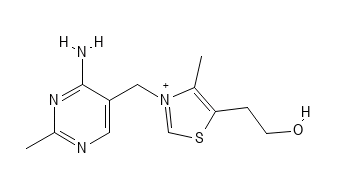
Figure 1: B1 – Thiamin
VITAMIN B2
- RIBOFLAVIN
The recommended daily dose of B2, which has previously been called Vitamin G, is approx. 1.4 mg/day for adults – slightly higher for pregnant and lactating women. No UL (Upper Limit) has been calculated, as not enough sufficient data is available, and it is not found to be necessary because B2 is very safe to ingest. It has only been observed that very high doses can cause abdominal pain and diarrhea.
VITAMIN B2 DEFICIENCY
Deficiency of B2 is rare and usually accompanied by a deficiency of other vitamins and nutrients – people at risk of deficiency are alcohol addicts, vegetarians and people who are very physically active. The deficiency condition is called ariboflavinosis, which manifests itself in, for example, lesions in the mouth or lips, inflammation of the mucous membranes of the mouth, sore throat, hair loss, inflammation of the skin and increased sensitivity to sunlight. It has also been seen that deficiency can inhibit the metabolism of minerals and iron, which is important for the production of hemoglobin and red blood cells, for example.
Good sources of B2 are, for example, meat, fish, poultry, eggs, dairy products, legumes, green vegetables, mushrooms, wild rice and almonds. As for B1, there are some countries in Africa, America and India where, for example, wheat flour and corn flour are enriched with B2. In foods, B2 is primarily protein-bound and is released via enzyme reactions before being absorbed across the gut.
FUNCTION OF B2 IN THE BODY
In the body, B2 is found in the form of Riboflavin and the two active forms are FAD and FMN. That is, Riboflavin is a precursor for FAD* and FMN**, both of which are important coenzymes, for example in energy production. The body can convert these coenzymes into each other as needed. B2 is involved in the citric acid cycle in the form of FAD which transports electrons to the electron transport chain to form ATP. It is also involved in several reaction steps that take place before the citric acid cycle in the metabolism of proteins and fats and in the activation of other vitamins (e.g. B3, B6 and B9) and in the formation of the very important antioxidant Glutathione and the formation of antibodies – around 70-80 enzyme reactions in humans are supported by B2-derived coenzymes. In this way, B2 is important for e.g. the immune system and the formation of energy which is fundamental for all cells. In addition, B2 has an antioxidant and anti-inflammatory function and is involved in maintaining a normal level of homocysteine – an amino acid which at high levels indicates an increased risk of cardiovascular disease and is therefore used as a marker for it.
* FAD is the abbreviation Flavin Adenine Dinucleotide
** FMN is the abbreviation Flavin MonoNucleotide
*** Histamine is one of the best-known mediators of proinflammatory reactions in the skin e.g. by insect bites and is the primary endogenous itch-inducing substance.
Several animal experiments suggest that B2 can also affect pain experiences, and some suggest that in combination with other drugs it can reduce migraine attacks – however, there are not many studies with people regarding this possible property. It is excreted in the urine and gives the urine the yellow color.
Riboflavin in pure form is a water-soluble, yellow-orange solid with a faint odor and a bitter taste. It is somewhat/rather heat stable, but it is degraded by sunlight and then becomes a pro-oxidant (photosensitizer), so that it can damage the tissue it is in contact with. It is therefore relevant to include antioxidants if Riboflavin is to be used in light – or to protect Riboflavin in a way, such as by encapsulation. Figure 2 shows the structure of Riboflavin, which is a relatively small molecule with three ring structures and a side chain. The biosynthesis of Riboflavin takes place in bacteria, fungi and plants. It is produced industrially today mainly by fermentation methods using certain fungal species or GMO bacteria. It is used for medicine, dietary supplements and as an additive in food (E101) – i.a. to give color to foods. In addition, an animal study has shown that Riboflavin can reduce histamine-induced*** itching – by oral administration. Riboflavin is one of the allowed coloring agents in cosmetics but is not used very much in cosmetics.
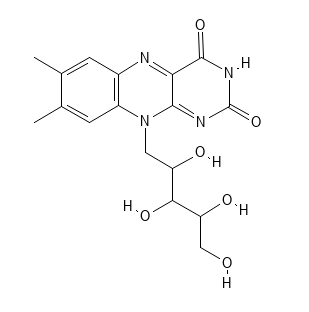
Figure 2: B2 – Riboflavin
VITAMIN B3
- NIACIN
The recommended daily dose of B3 is 11-16 mg/day for adults and a UL has been set – a max oral dose of 35 mg/day – mostly based on the fact that B3 can cause a temporary redness in the skin if more than 100 mg is ingested. However, cases of nausea, vomiting, headache, itchy and burning sensation in the skin as well as diarrhea and in very rare cases liver damage at very high doses above 1000 mg have also been observed.
The body can produce B3 from the essential amino acid tryptophan in the liver, but generally not to a sufficient degree and therefore B3 is categorized as a vitamin and food is the primary source of B3. Lack of B3 (and tryptophan) causes the disease pellagra, which was discovered in 1937 – this is why the compound previously was named vitamin PP, which stood for "Pellagra Preventive". The most visible symptoms are hyperpigmentation, eczema, and inflammation of the skin – primarily on sun-exposed areas. Other symptoms include diarrhea, inflammation of the mouth, aggression, weakness, mental confusion, difficulty concentrating, sleep problems and dementia. Severe deficiency can result in death.
Good sources of B3 are, for example, meat, fish such as tuna and salmon, poultry, nuts, legumes, vegetables, whole grains and seeds. In some countries, foods such as wheat flour are enriched with B3 or a B3 derivative. Vitamin B3 is Niacin, which is often called Nicotinic Acid. The most common derivative, which is often the substance used (e.g. in cosmetics and supplements) is Nicotinamide, which is also called Niacinamide. Chemically, the substances are very similar – the only difference is that the OH group in Niacin has been replaced by an NH2 group in Niacinamide (see Figure 3). The body can utilize Niacin and Niacinamide equally, but Niacinamide does not have the same effect in relation to the fact that Niacin has been shown to modify the lipid balance in the body and does not give the same side effects at high doses – such as flushing of the skin.
THE EMERGENCE AND FUNCTION OF VITAMIN B3 IN THE BODY
B3 is found in the body in the form of Niacin and Niacinamide – and these are precursors to the coenzymes: NAD+ and NADP+* – i.e. Niacinamide is part of the chemical structure of NAD+ and NADP+. These coenzymes are important in over 40 redox reaction processes, which take place in all cells in the body. They are found in this oxidized form and in their reduced forms – NADH and NADPH, where they carry a Hydrogen atom with associated electrons which can be passed on in other reactions such as in the electron transport chain and thus act as a form of energy transport and storage. NAD+/NADH is primarily involved in the breakdown of carbohydrates, proteins, alcohol and lipids and in the citric acid cycle, while NADP+/NADPH is more involved in the constructive reactions of e.g. fatty acids and cholesterol (which is an important part of steroid hormones) and in the (re)activation of the important antioxidant Glutathione. In addition, they are involved in DNA repair reactions and in the formation of components for the immune system and have anti-inflammatory properties. As they are generally very important for energy metabolism, it is especially areas in the body with a very high energy consumption and high cell turnover that are affected by deficiency: the brain, intestines, and skin.
Both Niacin and Niacinamide are absorbed easily and quickly from the stomach and small intestine and unlike many other vitamins, the uptake is not reduced with increasing dose, so even doses of 3 g grams are absorbed almost completely. Niacinamide is the primary form in the blood, and this is converted in the liver to NAD+, which can then be converted to NADP+ – and these can be hydrolyzed back to Niacinamide and Niacin. Like the other B vitamins, B3 is excreted primarily in the urine.
In nature, B3 is biosynthesized in both plants and animals – also most often from the amino acid Tryptophan, although some organisms can use other molecules as starting material. Industrially, Niacin and Niacinamide can be chemically synthesized via various reaction pathways.
Niacin and Niacinamide are relatively small water-soluble molecules, which in pure form are colorless, solids and not particularly heat stable. It is most often Niacinamide that is used in both medicine, dietary supplements and in cosmetics, as Niacin can dilate the blood vessels and thereby give an unintended flushing of the skin, which is reversible.
THE USE OF VITAMIN B3 IN COSMETICS
In relation to the skin, Niacinamide is probably the B vitamin that is used most in cosmetics and with good reason – it has many well-documented and positive properties in the skin, and it has been used in cosmetics for more than 50 years with very few reports of side effects, so it is both effective and very safe to use in cosmetics. In cosmetics, 2-5% Niacinamide is usually used to have an effect and these are also the levels used in most studies. It has been proven that Niacinamide can be absorbed – both in in vitro experiments with a Franz diffusion cell (which is a widely used method to assess skin permeability) and in vivo by measuring that NADPH increases in the skin after application. It has also been proven that the level of NADH and NADPH in the skin decreases with age. It is not entirely clear whether Niacinamide is converted in the skin to Niacin and it is possible that Niacin has some additional effects, but the unwanted flushing effect means that Niacin is not very suitable for cosmetics and the vast majority of studies have been performed with Niacinamide. The studies have shown that Niacinamide can have a positive effect in relation to acne, wrinkles, pigment spots and strengthen the skin barrier. In addition, Niacinamide has also been involved in studies on wound healing and skin diseases such as cancer, psoriasis, and rosacea. Not all details are known about all the mechanisms behind the many good properties, but the fundamental role of Niacinamide as a precursor for NAD(H) and NADP(H) probably plays a significant role in many of its properties for the body and skin. NADPH has been shown to have an antioxidant effect, affecting several aspects of the body and skin – such as collagen status – and it is known that oxidative stress plays an important role in many different skin problems and diseases. In the following, many of the cosmetic and dermatological interesting properties of Niacinamide will be presented.
* NAD+ is the abbreviation for Nicotinamide Adenine Dinucleotide. NADP+ is the abbreviation for Nicotinamide Adenine Dinucleotide Phosphate.
** TEWL is the abbreviation for Trans Epidermal Water Loss.
IMPROVEMENT OF THE SKIN BARRIER
The skin barrier is fundamental for functional skin; a compromised skin barrier can contribute to various skin problems such as sensitive skin, eczema, dry skin, and contact allergies. Therefore, improving the skin barrier can help prevent and reduce such issues. It has been shown that Niacinamide can enhance the skin barrier by upregulating the synthesis of ceramides and other important intercellular lipids, such as fatty acids and cholesterol, in the skin. For example, a placebo-controlled in vivo study demonstrated that using a topical product containing 2% Niacinamide for 4 weeks significantly increased the amount of ceramides and free fatty acids in the upper layer of the skin (stratum corneum) compared to the same topical formulation without Niacinamide (placebo). A clear reduction in TEWL** was also observed, which is a measure of how much water evaporates from the skin and, thus, an indicator of skin barrier function. Another way Niacinamide improves the skin barrier is by stimulating keratinocyte differentiation, thereby increasing epidermal turnover. Finally, it has been observed that Niacinamide can increase the thickness and moisture capacity of the stratum corneum, further contributing to an improved skin barrier.
Niacinamide can regulate lipid (sebum) production in sebaceous glands and has potent anti-inflammatory effects, both of which are important factors in the development of acne. Several in vivo studies have been conducted with topical products containing 2–5% Niacinamide applied over 4–8 weeks, demonstrating positive effects on acne. In vitro studies have shown that Niacinamide can inhibit the synthesis of inflammatory mediators such as prostaglandins and interleukin-8 in keratinocytes and skin models exposed to UV light. In a clinical in vivo study, it was shown that 5% Niacinamide applied to the skin before UV exposure reduces the redness (inflammation) that would otherwise be induced.
Melanin is a group of substances that give skin its color and protect it from the sun's rays. It is produced in melanocytes and transferred to keratinocytes via so-called melanosomes. Studies suggest that Niacinamide inhibits this transfer, thereby reducing skin pigmentation. Several in vivo studies with topical products containing 5% Niacinamide applied over 4–12 weeks have shown a significant reduction in the size and visibility of pigmentation spots, as well as improvements in skin texture. For instance, a placebo-controlled study involving 50 individuals with sun-damaged skin demonstrated that applying a topical product with 5% Niacinamide for 12 weeks resulted in several positive effects on the skin: it reduced fine lines, wrinkles, and pigmentation spots, and improved skin elasticity. The reduction in pigmentation spots appears to be dose-dependent and reversible.
Yellowing of the skin may result from a series of spontaneous oxidative reactions between proteins and sugar molecules—known as Maillard reactions or protein glycation. This leads to cross-linked proteins that can accumulate in the skin matrix, giving it a yellowish tone. It is believed that the antioxidant properties of Niacinamide, or its derivatives NAD+ and NADP+, enable Niacinamide to inhibit this yellowing of the skin, as it occurs as a result of oxidative stress.
Wrinkles and fine lines primarily arise due to reduced skin hydration, thinner skin, and a decrease in essential dermal components such as collagen, elastin, and other skin proteins. In vitro studies have shown that Niacinamide, as a precursor for NAD+ and NADP+, stimulates the synthesis of collagen, keratin, filaggrin, and involucrin in the skin. It has been confirmed in vivo that Niacinamide increases the expression of collagen (types I, III, and V), elastin, and fibrillin (1 and 2), while reducing certain matrix metalloproteinases (MMP 1, 3, and 9) and elastase, which are enzymes that break down collagen and elastin in the skin—both in non-UV-exposed skin and skin exposed to UVA radiation. Several placebo-controlled in vivo studies using Niacinamide in concentrations of 2.5–5% have demonstrated its ability to reduce wrinkles and fine lines while improving skin elasticity.
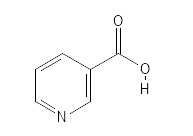
Figure 3: B3 – Niacin
VITAMIN B5
- PANTOTHENIC ACID
The recommended daily dose of B5 is 5 mg/day for adults and slightly higher for breast-feeding women. No UL has been set as it is a very safe compound to ingest, also in high quantities. B5 deficiency is very rare, but can cause symptoms such as fatigue, lethargy, nausea, acne, sensory disturbances and muscle cramps – all reversible symptoms. Vitamin B5 is one substance: Pantothenic acid – the name comes from the Greek "Pantos" which means "from everywhere" as this substance is found (in small amounts) in almost all foods.
Good sources of B5 are, for example, dairy products, eggs, fish, potatoes, tomatoes, whole grains, sunflower seeds, avocados and mushrooms. As with the other B vitamins, there is usually not much left of this vitamin after processing wheat into wheat flour and rice into rice flour – especially not if the outer layer of the grain has been removed. However, since it is found in so many foods, deficiency is very rare and therefore there is no requirement for food enrichment in any countries.
THE FUNCTION OF VITAMIN B5 IN THE BODY
In the body, B5 is the precursor to the very important coenzyme A – often abbreviated CoA. As mentioned, CoA is essential in many reactions in, for example, the metabolism of fats, proteins and carbohydrates and in the form of Acetyl CoA it is also directly involved in the citric acid cycle and is thus an important source of energy. Acetyl CoA is also involved in the biosynthesis of e.g. steroid hormones, phospholipids, the hormone melatonin and the neurotransmitter acetylcholine. In this way, B5 is very important for the body in many aspects. In foods, B5 is found primarily in the form of CoA or bound to proteins. In the intestines, B5 is released, after which it can be absorbed over the intestine and can be included in the biosynthesis of CoA. B5 is not stored in the body and like the other B vitamins it is excreted primarily via the urine.
DEVELOPMENT AND MANUFACTURE OF VITAMIN B5
In nature, B5 is biosynthesized in plants and some bacteria from e.g. the amino acids Aspartate and Valine. Industrially, B5 can be produced via chemical synthesis, and it can also be isolated from bacteria. Pantothenic acid (B5) is in pure form slightly yellowish crystals without fragrance and is not very stable to acid, base or heat – it is a relatively small molecule; see the structural form in Figure 4. Therefore, more stable derivatives such as Calcium Pantothenate and the alcohol derivative Panthenol, which the body can convert to Pantothenic acid, are often used. B5 is included in both medicine, dietary supplements and cosmetics.
* Pantothenic acid and its derivatives such as Panthenol are found in two different spatial structures, which often have the prefix "D" (stands for "dexter") or "L" (stands for "laevus"). It is the D versions that are biologically active. Therefore, the word "Dexpanthenol" is sometimes used when denoting the pure D-panthenol.
THE USE OF PANTHENOL IN COSMETICS
In relation to cosmetics, it is usually Panthenol* that is used, and many studies have been done with this substance, which show positive properties in relation to use on the skin. 1-5% Panthenol is typically used in products for the skin and studies have shown that the substance can be absorbed relatively quickly into the skin and can be converted to pantothenic acid. The substance is hygroscopic, which means that it can bind water to itself and is thus good at retaining moisture in the skin and absorbing moisture to the skin. The moisture in the skin plays a crucial role for the skin's many physiological and mechanical properties and for the appearance of the skin. Studies have also shown that Panthenol can, for example, improve the skin barrier, stimulate wound healing, reduce skin irritation, and have anti-inflammatory properties. Mechanisms of action behind all these properties have not been fully elucidated, but some of them are because Panthenol (B5 derivative) is a precursor to Coenzyme A (CoA). Panthenol is also a very safe and mild substance and has, for example, been used on sensitive skin, eczema skin and small children with irritation in the diaper area without giving any kind of irritation – on the contrary with positive results. A study has also shown that Panthenol does not adversely affect the skin microbiota.
A poor skin barrier and lack of moisture in the skin play an important role in many skin problems and thus a substance like Panthenol can have a positive effect on several different skin problems and on healthy skin by improving and maintaining a good skin barrier and moisture. A possible mechanism behind - in addition to the hygroscopic property - is that CoA participates in the synthesis of lipids which are important components in the outer layer of the skin (stratum corneum) and the skin barrier and possibly by promoting epidermal differentiation, which is also important in wound healing. Both in vitro and in vivo experiments have shown that Panthenol (5%) promotes wound healing. Similarly, several in vivo trials on various types of damaged skin with 2.5-5% Panthenol for 7-28 days have shown significant improvement in skin moisture and barrier. A study with healthy skin has, for example, shown that the skin's tolerance to irritants was increased – presumably by maintaining a good barrier and moisture in the skin. Panthenol has been used successfully in topical products for over 70 years.
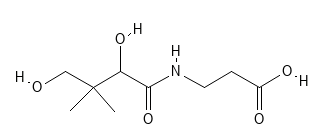
Figure 4: B5 – Pantothenic acid
VITAMIN B6
- PYRIDOXINE, PYRIDOXAL AND PYRIDOXAMINE
The recommended daily dose of B6 is approx. 1.5 mg/day for adults and slightly higher for pregnant, breastfeeding women and the elderly, as B6 uptake generally decreases with age. In addition, the need for B6 is increased by a large intake of alcohol and protein. A UL of 100 mg/day has been set, which is based on reports of reversible sensory neuropathy following ingestion of more than 1000 mg/day for a longer period. Some studies suggest that a significant portion of the earth's population does not receive the recommended amount.
VITAMIN B6´s EGENSKABER PROPERTIES OF VITAMIN B6
B6 deficiency can, for example, cause eczema, anemia, confusion, depression, a weaker immune system and elevated levels of the amino acid homocysteine in the blood, which is associated with cardiovascular disease. In addition, deficiency is associated with a variety of diseases such as diabetes, cardiovascular disease, cancer, and inflammation in the body. Conversely, for example, a clear relationship has also been seen with B6 intake and incidence of cancer in the form of the higher the intake the lower the incidence of cancer – the strongest correlation was seen with gastrointestinal cancer. However, it is not entirely clear whether B6 directly inhibits cancer or whether B6 is just a marker for healthy eating and other factors are actually the inhibitors of cancer.
Too high doses can cause headaches, numbness, and fatigue and some suggest that it can generate dangerous substances by UV radiation and cause neurological damage. Animal experiments point to an interaction between B6 and UV radiation, which may be responsible for a higher risk of skin cancer.
Good sources of B6 are e.g. fish, legumes, poultry, cereals and some fruits and vegetables.
B6 is not one single substance, but a group of 3 chemically related molecules: Pyridoxine, Pyridoxal Pyridoxamine (see the structures in Figure 5) and their phosphorylated derivative, which are biologically more active substances – of which the phosphorylated form of Pyridoxal, Pyridoxal 5'- phosphate, is the biologically most active form of B6. The body can convert the 6 forms into each other and thus from e.g. Pyridoxine, which is especially found in foods and supplements e.g. form the most active version, Pyridoxal 5 'phosphate.
PROTECTIVE VITAMIN
In the body, B6 – primarily in the form of Pyridoxal 5 'phosphate – is a very important coenzyme for a number of enzymes; about 150 biochemical reactions need B6. Many of these reactions are related to the degradation of proteins as well as the biosynthesis and degradation of amino acids and neurotransmitters such as serotonin, dopamine, norepinephrine and melatonin. In addition, B6 is also involved in the metabolism of carbohydrates and fats and in the formation of hemoglobin, certain antibodies and hormones. So, the importance of B6 is not to be overlooked and research is being done on whether B6 and the enzymes it is coenzyme for can be targets for the treatment of various diseases - e.g., malaria, cancer, high blood pressure and diabetes. In addition to being a coenzyme, B6 is also an antioxidant that, for example, can inhibit lipid peroxidation with potency similar to Vitamin E. It has also been shown that B6 can inhibit the formation of Advanced Glycation Endproducts (AGE) and Advanced Lipoxygenation Endproducts (ALE), both of which are related to oxidative stress. These can accumulate and in the long run be harmful to various tissues in the body such as the heart, nerves, eyes and kidneys - it has also been seen that AGE accumulation in the skin is associated with aging of the skin.
B6 is biosynthesized in certain bacteria and yeast cells, while most animals, including humans, cannot and are thus dependent on consuming it through food. Some intestinal bacteria can form B6, but not sufficiently. Industrially, the B6 substances can be produced by chemical synthesis – they are used, for example, in dietary supplements and for medical purposes to prevent deficiencies and, for example, also in special types of fungal poisoning. B6 is not used to any great extent in cosmetics. It is not entirely clear whether it has positive properties when used topically and in addition there is some evidence that it can be harmful when exposed to UV radiation.
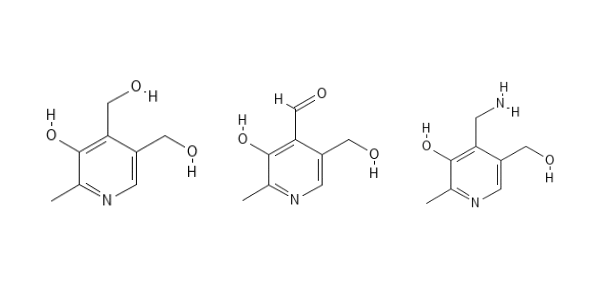
Figure 5: B6 – Pyridoxine, Pyridoxal og Pyridoxamine
VITAMIN B7
- BIOTIN
The recommended daily dose of B7, previously called Vitamin H, is approx. 30-40 µg/day for adults – a little higher for pregnant and breastfeeding women. Alcohol, some medications as well as certain congenital mutations in genes that are involved in the utilization of B7 may increase the need for B7. There is no UL – max oral dose, as there is no sufficient data to suggest that it is dangerous even at very high levels. A normal balanced diet usually covers the need for B7; therefore deficiency is very rare. Symptoms of deficiency are hair loss, weak nails, eczema, balance problems, cramps, lethargy, eye inflammation and depression.
Good sources of B7 are e.g. nuts, beans, seeds, liver, whole grains, salmon, yeast and eggs (but not raw eggs as the egg white contains the protein avidin, which binds biotin and thus prevent its absorption by the intestine). In foods, B7 is bound to proteins, from which it is released by enzymes in the intestine so that the Biotin molecule can be absorbed primarily through the small intestine. The absorption is very effective so even very high intakes of B7 are absorbed over the intestine. In addition, there are bacteria in the colon that biosynthesize B7. It is estimated that these bacteria produce about as much B7 as a normal diet contains, but it is unknown how much of this amount of B7 is absorbed into the body. From the intestine it is comes to the liver by the blood flow. Uptake into the liver is dependent on a specific transporter protein, which also binds and transports B5, which means that B5 and B7 compete for the space in this protein and thus can affect each other’s uptake into the liver. From the liver, it is distributed via the blood vessels to all the tissues of the body. Excretion from the body occurs primarily via the urine.
STRENGTHENS HAIR AND NAILS
In the body Biotin is coenzyme for 5 carboxylase enzymes, which play key roles in the metabolism of both fats, carbohydrates and proteins – for example in the formation of sugar molecules from pyruvate and amino acids, the biosynthesis of fats and the formation of proteins such as keratin. Keratin is the main component in e.g. hair and nails, which is why Biotin deficiency is linked to hair and nail growth. In addition, Biotin can bind to specific proteins that affect the transcription of genes.
B7 is biosynthesized by plants and bacteria. Industrially, it is primarily produced by chemical synthesis. It is a relatively small molecule – see Figure 6. In pure form, it is a white or colorless water-soluble powder that is reasonably heat stable. It is used especially in dietary supplements and also in medicine and biotechnological methods to isolate proteins, and also a little in cosmetics. The purpose in supplements and cosmetics is often to strengthen hair and nails, but there is no clear evidence for its effect. In particular, studies have been done with Biotin as a dietary supplement, which, however, indicate that it has no statistical effect on healthy people – some studies show that people who have a type of disease that causes them not to utilize Biotin well enough, can have a positive effect on hair and nails by taking biotin as a dietary supplement.
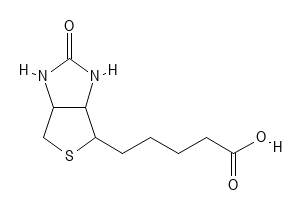
Figure 6: B7 – Biotin
VITAMIN B9
- FOLATE (FOLIC ACID)
B9, formerly called Vitamin M, has a recommended daily dose of approx. 400 µg/day for adults – 600/500 µg/day for pregnant and lactating women respectively. UL - max oral dose - is set to be 1000 µm/day for adults; this applies to dietary supplements, as it has been assessed that there is no risk of high intake via the diet. The reason for the UL is because very high doses can hide a deficiency of vitamin B12, which can cause a form of anemia. Deficiency of B9 can also result in anemia however, as well as symptoms such as fatigue, shortness of breath, sores on the tongue, change in the color of the skin and hair, elevated levels of homocysteine, diarrhea and depression. Deficiency in pregnant women can cause birth defects such as neural tube defects. In addition, B9 deficiency has been linked to an increased risk of a number of cancers.
Good sources of B9 are, for example, asparagus, spinach, broccoli, nuts, lentils, chickpeas, milk and offal such as chicken livers. In several countries, there are requirements or proposals to enrich foods with B9 – such as wheat flour, corn flour and rice. B9 is the most common fortified vitamin. The reason is in particular that B9 is relatively unstable, and several studies have shown that part of the earth's population does not receive the recommended dose.
The term B9 is usually used for Folate (Folic acid) – shown in Figure 7 – but is also often used for very similar substances, which are often called folates - e.g. folacin, and folic acid and are the active and primary forms in the body. "Folate" is sometimes used a little differently depending on whether the subject is chemistry, biochemistry or nutrition. The word "folic acid" is often used for the synthetically produced forms, while the natural forms are often called folates. The natural folates usually contain several glutamate units in a chain, which are broken down in the body into folic acid. In the body it is found in several different forms: the primary active forms are Tetrahydrofolic acid (Tetrahydrofolate; THF) and Methyltetrahydrofolate (5-MTHF, also known as Levomefolic acid) – the latter of which is the most common in the blood.
B9 in the form of folic acid is thus a precursor to THF and 5-MTHF, which are coenzymes for a number of enzymes that are necessary in, for example, biosynthesis, repair and methylation of DNA and RNA. These are very basic functions for cell division, maintenance, growth and e.g. the production of red blood cells – so it is not difficult to imagine that e.g. deficiency during pregnancy can have fatal consequences for the fetus and deficiency in adults can also have severe consequences. THF and 5-MTHF are also involved in the conversion of the amino acid homocysteine to the essential amino acid methionine. B9 and B12 are particularly connected in the two coupled reaction patterns folate cycle and methionine cycle, so that lack of one affects the effect of the other. These two also have a special connection to iron, as a deficiency of B9 or B12 can hide a deficiency of iron - thus these three substances should be in balance.
USE OF VITAMIN B9 IN COSMETICS
B9 is biosynthesized in plants, fungi, certain protozoa and bacteria. Industrially, it is usually produced by chemical synthesis and often in the form of more stable derivatives - which is used in dietary supplements, for example. The natural forms of B9 are not very stable to heat and light - especially not in a low pH environment. During UV irradiation, it degrades i.a. to a substance that can be harmful to cells, so it is debated whether B9 is ideal to use in topical products – some studies are looking at the possibility of using more stable versions, which in the skin could be converted to the active substance. It is believed that the melanin of the skin has a protective effect on B9 in the skin in relation to UV radiation.
However, since UV radiation can damage the skin's DNA and B9 is important for DNA repairs, it is possible that B9 could benefit the skin. A study with both in vitro and in vivo experiments has shown that B9 can enter the skin (via a suitable protective cream vehicle) and that it did not damage the skin. In the same study, it was shown that UV radiation can affect the cells to express higher levels of certain intracellular proteins that contribute to the uptake of B9.
Today, B9 is not widely used in cosmetics, although some studies suggest that it could have a positive effect – for example, an in vitro experiment has shown that Folic Acid together with Creatine accelerated skin rebuilding and an in vivo experiment has shown that Folic Acid together with Creatine had a protective effect against UV-induced DNA damage and increased the firmness of the skin and reduced wrinkles - probably partly due to an increased collagen density.
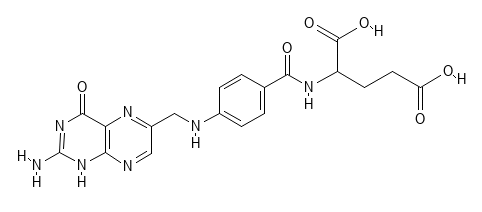
Figure 7: B9 – Folate (Folic acid)
VITAMIN B12
- COBALAMIN
The recommended daily dose of B12 is 2-4 µg/ ay for adults and slightly more for pregnant and breastfeeding women. There is no UL, as it is generally believed that B12 is very safe to ingest and easily excreted. However, there are studies that show that very high doses can cause lesions on the skin and a form of acne-like rash – however, the correlation has not been fully established. There is also no consensus about which concentration limits in the blood of B12 are judged to be too much and too little. Elevated levels of B12 have been seen in several different disease states, e.g. in some types of leukemia, but no clear causal relationships has been established.
Deficiency of B12 will often first manifest in the form of hyperpigmentation, changes in hair and nails and inflammation of the tongue. In addition, deficiency can cause fatigue, balance problems, shortness of breath, memory loss, elevated homocysteine, poorer immune system and in the long run a form of anemia, neuritis, reduction in cognitive abilities, psychosis, and reduced fertility. Deficiency is rarely due to too low an intake via the diet - however, vegetarians and vegans can be in deficit as B12 is mostly found in animal foods. The most common cause of deficiency is poor absorption, which is seen, for example, in the elderly and people who have reduced levels of proteins needed for absorption or have a too low level of stomach acid, which may be due to antacids. Deficiency of B12 is worldwide one of the most common vitamin deficiencies, which is why it is also relatively common and in some places a requirement to enrich foods such as plant milk, wheat flour, corn flour, bread, pasta and rice.
Good sources of B12 are animal foods, especially offal, eggs and fish. In addition, yeast and milk as well as seaweed and fermented foods with B12-containing microorganisms. It is only bacteria that can biosynthesize B12 and the reason why animal products contain B12; likewise, B12 is biosynthesized by some bacteria in the human colon, but how much is absorbed is not entirely known – the primary uptake occurs in the small intestine in humans.
THE FUNCTION OF VITAMIN B12 IN THE BODY
B12, also called Cobalamin, is chemically a very complex vitamin, containing the metal Cobalt. It covers several very similar substances (cobalamins), of which Cyanocobalamin (shown in Figure 8) together with Methylcobalamin are the most common in e.g. dietary supplements. In the body, the two biologically active forms of B12 are Methylcobalamin and Adenosylcobalamin. Methylcobalamin is a coenzyme for the enzyme Methonine synthase, which converts homocysteine to Methonine, which is important in the also B9-dependent biosynthesis of the nucleic acids pyrimidines and purines, which are the starting materials for the biosynthesis of DNA and RNA. Adenosylcobalamin is the coenzyme for the enzyme Methylmalonyl CoA mutase, which is important in the breakdown of fatty acids and proteins. More generally, B12 is necessary for the normal functioning of the bone marrow, where the red blood cells are formed, the breakdown of fatty acids and proteins, the formation of DNA and RNA, the nervous system and it also affects the immune system.
In foods, B12 is most often bound to proteins from which it is released in the stomach or in the beginning of the small intestine. To protect B12 from the acid in the stomach, it binds to the protective protein Haptocorrin, from which it is released again in the intestine, so that B12 is in free form in the intestine. In order to be absorbed through the small intestinal wall and enter the bloodstream, it must bind to another protein, Intrinsic factor, which causes it to be carried to the liver and from there into the bloodstream. With the blood, B12 – which here is primarily bound to Haptocorrin again – is distributed to the rest of the body's cells, where it is again released and can be transformed into an active form. The uptake of B12 is thus quite complex and depends on several proteins, which means that there are several steps that can inhibit the uptake - e.g. due to mutations in one of the proteins that are necessary for the uptake. In addition, the uptake is not very effective (especially not in the elderly), so a relatively large part of the food's content of B12 is excreted with the feces. What is absorbed into the body is excreted via the urine. In the liver, about 50% of the body's B12 content is found, where it constitutes the largest stock of B12 of about 2-5 mg in adults. This stock lasts for several years, which is why it takes a long time before symptoms of deficiency appear.
MANUFACTURE AND OCCURRENCE OF B12
B12 is biosynthesized by some archaea and bacteria in the form of Methylcobalamin and Adenosylcobalamin. Industrially, B12 is most often produced via fermentation with certain bacteria followed by isolation and a chemical process to make it into Cyanocobalamin. It can also be synthesized, but it is a very complex synthetic route with over 60 steps, which is not profitable.
B12 is a relatively large and complex molecule that is water-soluble, light-sensitive and in pure form a deep red powder.
In dietary supplements and food enrichment, the Cyanocobalamin form in particular is used, as the Cyanide unit stabilizes the molecule. B12 is also found in medicines in the form of tablets and as an injection, which can be used in case of deficiency. As with everything else, there is a risk (albeit small) of side effects such as allergies and anaphylactic reaction – some people are sensitive to cobalt, for example.
PROTECTS AGAINST ECZEMA AND INFLAMMATION IN THE SKIN
In relation to the skin, both too much and too little B12 can result in skin issues. Some studies suggest that B12 may have a protective effect against eczema and inflammation of the skin – probably by reducing the production of nitric oxide (which, in too high amounts, is proinflammatory) and proinflammatory cytokines. When used topically, B12 itself has a very low skin permeability, which is why there are some studies that use special delivery systems such as liposomes to increase absorption. For example, a mouse study showed that liposomes containing Adenosylcobalamin in a hydrogel gave a better skin permeability and had a marked positive effect on induced atopic eczema. In a placebo-controlled study in people with atopic eczema, a cream containing 0.07% cyanocobalamin over 8 weeks showed a significant improvement in the condition compared to the same formulation without cyanocobalamin. And there are several studies that have shown that B12 can have a beneficial effect on eczema. B12 has also shown a positive effect in the form of an ointment with 0.07% Cyanocobalamin against mild-to-moderate plaque psoriasis.
Compared to cosmetics, B12 is not very widely used; perhaps because it gives a red color and because some studies suggest that too much B12 can aggravate acne. However, there are also studies that suggest that it may act as an antioxidant, be anti-inflammatory, as well as reduce itching and irritation of the skin.
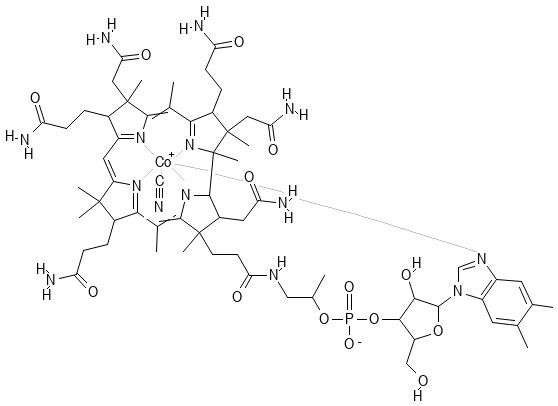
Figure 8: B12 – Cyanocobalamin
SOURCES:
Boo Y. C. Mechanistic Basis and Clinical Evidence for the Applications of Nicotinamide (Niacinamide) to Control Skin Aging and Pigmentation. Antioxidants (Basel, Switzerland). 2021; 10(8), 1315.
Brescoll, J.; & Daveluy, S. A review of vitamin B12 in dermatology. American journal of clinical dermatology. 2015; 16(1), 27–33.
Del Duca, E.; Farnetani, F.; De Carvalho, N.; Bottoni, U.; Pellacani, G.; & Nisticò, S. P. Superiority of a vitamin B12-containing emollient compared to a standard emollient in the maintenance treatment of mild-to-moderate plaque psoriasis. International journal of immunopathology and pharmacology. 2017; 30(4), 439–444.
Ebner, F.; Heller, A.; Rippke, F.; & Tausch, I. Topical Use of Dexpanthenol in Skin Disorders. American Journal of Clinical Dermatology. 2002; 3(6): 427-433.
Fattal-Valevski, A. Thiamine (Vitamin B1). Journal of Evidence-Based Complementary & Alternative Medicine. 2011; 12–20.
Final Report on the Safety Assessment of Biotin. International Journal of Toxicology. 2001; 20(4_suppl), 1–12.
Fischer, F. et. al. Folic acid and creatine improve the firmness of human skin in vivo. Journal of Cosmetic Dermatology. 2011; 10 (1): 15-23.
Forbat, E.; Al-Niaimi, F.; & Ali, F. R. Use of nicotinamide in dermatology. Clinical and experimental dermatology. 2017; 42(2), 137–144.
Forum, H. Vitamin B x mange. Fagbladet Kosmetik, Maj 2021.
Hellmann, H., & Mooney, S. Vitamin B6: a molecule for human health?. Molecules (Basel, Switzerland). 2010; 15(1), 442–459.
Hua Gao-Balch, Y. Reconsider B-vitamins play a vital role in maintaining good health and well-being. Internal Medicine and Care. 2019; 3: 1,3.
Jung, S. H.; Cho, Y. S.; Jun, S. S.; Koo, J. S.; Cheon, H. G.; & Shin, B. C. Topical application of liposomal cobalamin hydrogel for atopic dermatitis therapy. Die Pharmazie. 2011; 66(6), 430–435.
Kato, N. Role of vitamin B6 in skin health and diseases. Kapitel i: Preedy, V.R. Handbook of diet, nutrition and the skin. Human Health Handbooks no. 1, vol 2. Wageningen Academic Publishers (2012).
Kennedy D. O. B Vitamins and the Brain: Mechanisms, Dose and Efficacy--A Review. Nutrients, 2016; 8(2), 68.
Knott, A. et. al. A novel treatment option for photoaged skin. Journal of Cosmetic Dermatology. 2008; 7 (1): 15-22.
Knott, A.; Mielke, H.; Koop, U.; Wolber, R.; Burkhardt, T.; Vietzke, J. P.; Stäb, F.; Wenck, H.; & Gallinat, S. Folic acid: cellular uptake and penetration into human skin. The Journal of investigative dermatology. 2007; 127(10), 2463–2466.
Lee, K.; Choi, Y. I.; Im, S. T.; Hwang, S. M.; Lee, H. K.; Im, J. Z.; Kim, Y. H.; Jung, S. J.; & Park, C. K. Riboflavin Inhibits Histamine-Dependent Itch by Modulating Transient Receptor Potential Vanilloid 1 (TRPV1). Frontiers in molecular neuroscience. 2021; 14.
Levin, J., & Momin, S. B. How much do we really know about our favorite cosmeceutical ingredients?. The Journal of clinical and aesthetic dermatology. 2010; 3(2), 22–41.
Lipner S. R. Update on Biotin Therapy in Dermatology: Time for a Change. Journal of drugs in dermatology: JDD. 2020; 19(12), 1264–1265.
Matts, P.; Oblong, J. & Bissett, D.L. A Review of the range of effects of niacinamide in human skin. International Federation of Societies of Cosmetic Chemists Magazine. 2002; 5. 285-289.
Patel, D. P.; Swink, S. M.; & Castelo-Soccio, L. A Review of the Use of Biotin for Hair Loss. Skin appendage disorders. 2017; 3(3), 166–169.
Proksch, E.; de Bony, R.; Trapp, S.; & Boudon, S. Topical use of dexpanthenol: a 70th anniversary article. The Journal of dermatological treatment. 2017; 28(8), 766–773.
Rembe, J.-D.; Fromm-Dornieden, C. & Stuermer, E. K. Effects of Vitamin B Complex and Vitamin C on Human Skin Cells: Is the Perceived Effect Measurable?, Advances in Skin & Wound Care: May 2018; V 31, Issue 5,p 225-233.
Shelomi M. Thiamine (vitamin B1) as an insect repellent: a scoping review. Bulletin of entomological research. 2022; 1–10.
Stach, K.; Stach, W.; & Augoff, K. Vitamin B6 in Health and Disease. Nutrients. 2021; 13(9), 3229.
Suwannasom, N.; Kao, I.; Pruß, A.; Georgieva, R.; & Bäumler, H. Riboflavin: The Health Benefits of a Forgotten Natural Vitamin. International journal of molecular sciences. 2020; 21(3), 950.
Website: https://www.preservskincare.com/blog/complete-guide-to-b-vitamins-in-skincare. Updated September 2020. Lokaliseret 27. April 2022.
Wikipedia websites:
https://en.wikipedia.org/wiki/B_vitamins
& https://en.wikipedia.org/wiki/Cofactor_(biochemistry)
& https://en.wikipedia.org/wiki/Thiamine
& https://en.wikipedia.org/wiki/Riboflavin
& https://en.wikipedia.org/wiki/Niacin
& https://en.wikipedia.org/wiki/Pantothenic_acid
& https://en.wikipedia.org/wiki/Acetyl-CoA
& https://en.wikipedia.org/wiki/Pyridoxine
& https://en.wikipedia.org/wiki/Pyridoxamine
& https://en.wikipedia.org/wiki/Biotin
& https://en.wikipedia.org/wiki/Folate
& https://en.wikipedia.org/wiki/Vitamin_B12
Lokaliseret 5. Marts 2022.
Williams, J. D.; Jacobson, E. L.; Kim, H.; Kim, M.; & Jacobson, M. K. Folate in skin cancer prevention. Sub-cellular biochemistry. 2012; 56, 181–197.
Yoshii, K.; Hosomi, K.; Sawane, K.; & Kunisawa, J. Metabolism of Dietary and Microbial Vitamin B Family in the Regulation of Host Immunity. Frontiers in nutrition, 2019; 6, 48.
